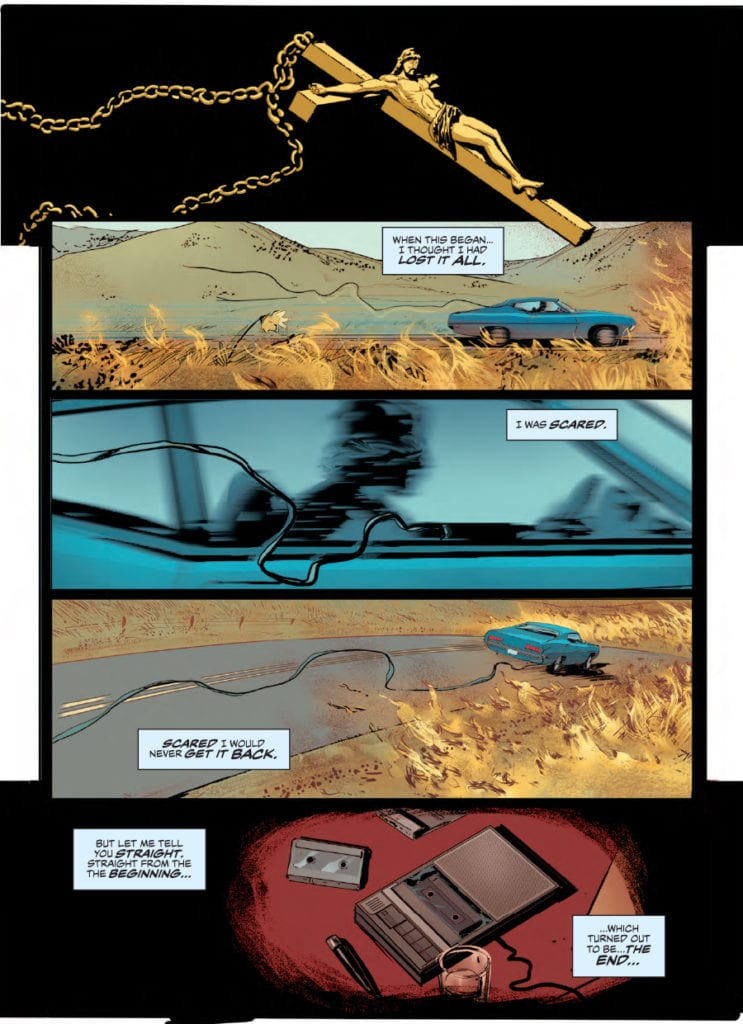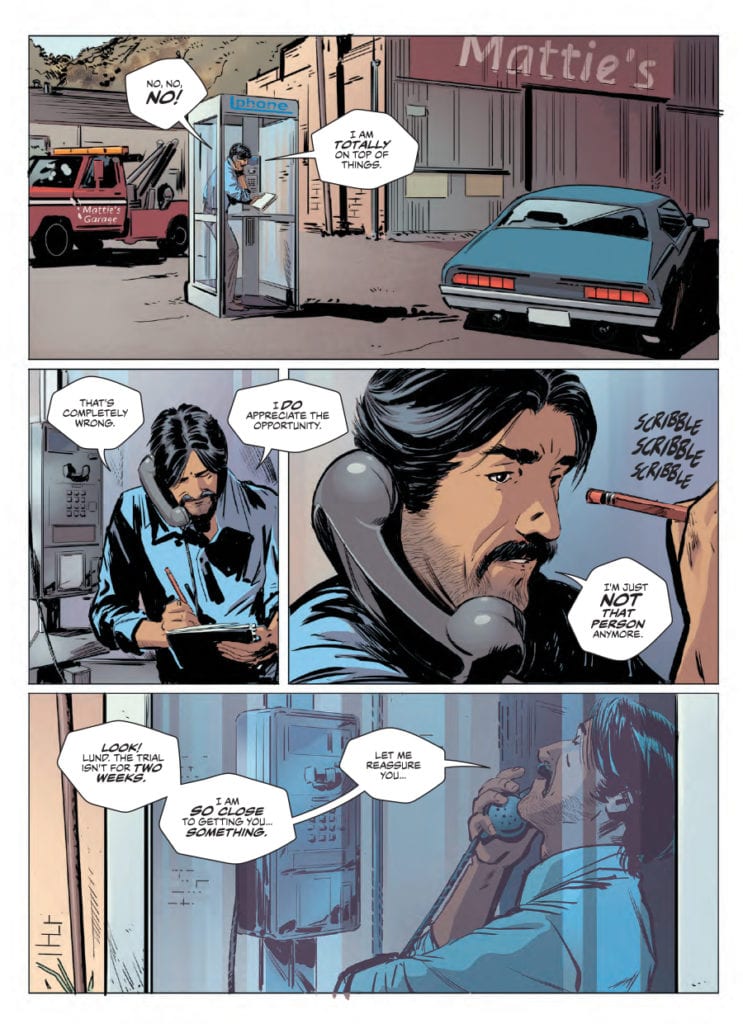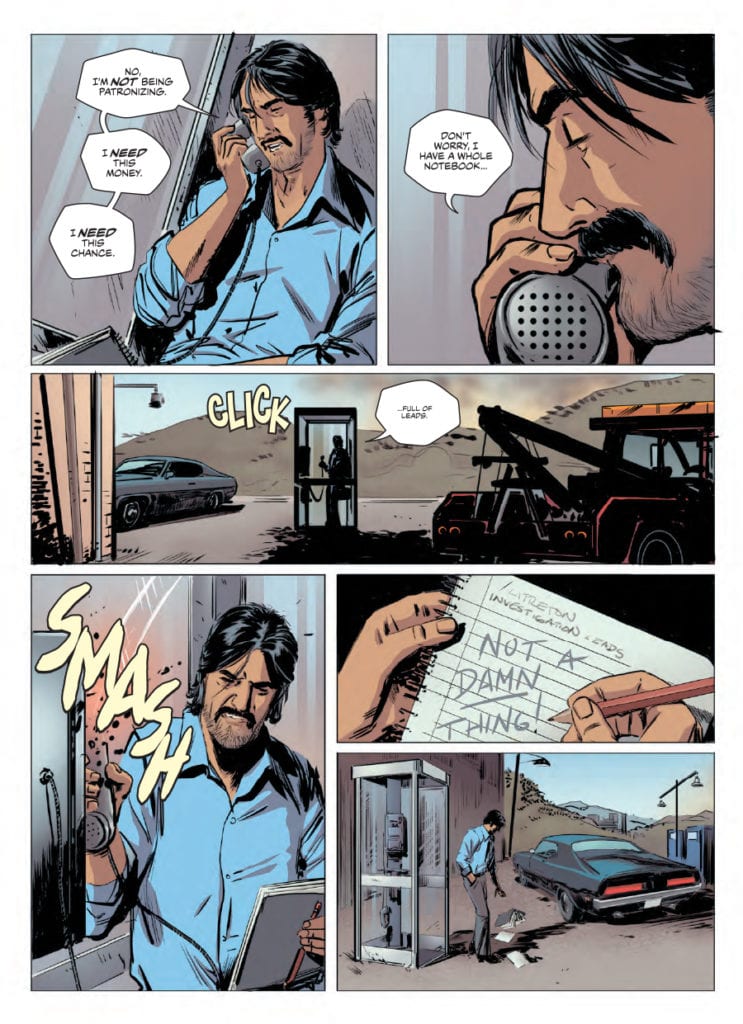Writer Chip Mosher teams with artist Peter Krause (Irredeemable), colorist Giulia Brusco, and letterer Ed Dukeshire to tell a 70’s grindhouse-noir tale full of fire, booze, and woe in Blacking Out. This Kickstarter graphic novel is a sharp read full of questionable folk, an ever-thickening plot, and stunning artwork. This all culminates in what has got to be one of the most insane twists in recent years – in this or any medium.
” Disgraced ex-cop, Conrad, seeks redemption by unraveling an unsolved murder during Southern California’s fire season. Connie follows a lone clue—a discarded crucifix—to unravel the death of Karen Littleton, whose body was found amid a blaze that scorched 10,000 acres. The search leads Connie to clash with the victim’s father and prime suspect, Robert Littleton, as well as hostile former colleagues on the local police force. All the while, Conrad combats his consuming alcoholism and fading faculties.”
Writing & Plot
In true crime-noir fashion, the protagonist for Blacking Out is a down on his luck ex-cop who meets a beautiful woman and decides to try and turn his life around when an investigation falls into his lap. Also in genre fashion, none of the characters including Conrad himself can be trusted to divulge the whole truth about anything at any time. This is a pressure cooker of a crime tale, with a slowly-building plot that makes the most of its 56-page runtime. The backdrop of a burning California landscape that encroaches on the setting is a clever plot-device that adds to the building tension of Connie’s investigation. Most of Connie’s “investigating” involves finding suspects and beating them until they talk, which is, of course, as it should be in a grindhouse crime comic. Conrad’s backstory is delivered in tidbits of both internal narration and meetings with old acquaintances. None of these moments feel bloated or forced, which is tough to accomplish in such a short format. This being said, Blacking Out is a plot-driven tale that uses characters as a vehicle rather than being character-focused. This is the case for most noir-tales with questionable characters, and this still makes for a wholly engaging comic for fans of the genre. The plot twist in the final pages is…impressive, to say the least. It’s a left hook that approaches insane twists the way they should be, with a trail of seemingly innocuous breadcrumbs that assemble to form a complete picture seemingly out of nowhere, just as you realize it was staring you in the face for the whole story. It’s brilliant. If there was any small complaint, it would be that Connie’s romantic interest, Anita, would be fleshed out more as a character. Most characters in the novel fill specific roles for the advancement of the plot, while Anita is the whole reason Conrad wishes to better himself and solve this case. She isn’t a bad character in any way, and her hold on Connie is compelling, I just wish she had been given more time in the story. This small complaint aside, the storytelling is solid grindhouse crime noir with enough grit and atmosphere to please any fan of the genre.
Art Direction
Blacking Out is gifted with the immense artistic talent of Peter Krause, best known for his work on Irredeemable and The Power of Shazam. His work here is as stellar as ever, with stellar character animations and detailed environmental drawings. Krause’s visual style here could be considered a more picturesque realism, which creates a cinematic perspective to pull the audience in. Due to noir’s history in film, this is a wise artistic choice, and it makes this graphic novel easy to get lost in. Much of the visual pull comes from Giulia Brusco’s colors which, aside from providing the dimension for the settings, has a sort of film grain aesthetic. This, along with the kind of smoky fog left in the air by the surrounding fire, makes Brusco’s work integral to the book’s visuals. She and Krause’s work here in Blacking Out is excellent and makes for a seamless read from an artistic standpoint.
Blacking Out is a gripping and entertaining crime-noir graphic novel that makes the most of its 56-page length. Chip Mosher’s script is sharp and tautly paced, lined with gritty narration and ending in one of the most memorable plot twists I’ve seen in any medium. Peter Krause and Giulia Brusco’s artwork, along with Ed Dukeshire’s solid lettering, makes for a visually superb experience that keeps the reader pulled into the heat of the story and its ever-thickening plot. Back this grindhouse affair on Kickstarter to get yourself a hardcover full of woe and fire in a burning California landscape.

